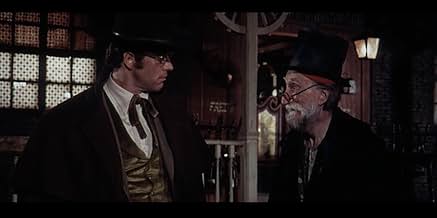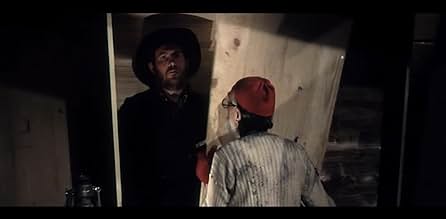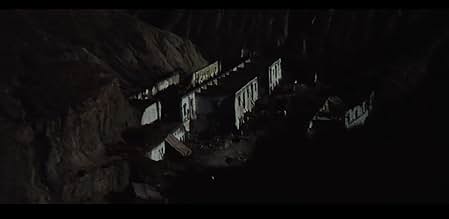Bespectacled pistolero Stan Ross comes to Canyon City and becomes involved with two feuding factions, after a clerk has been killed by the banker Jefferson during a botched holdup, while rob... Read allBespectacled pistolero Stan Ross comes to Canyon City and becomes involved with two feuding factions, after a clerk has been killed by the banker Jefferson during a botched holdup, while robbing his own bank.Bespectacled pistolero Stan Ross comes to Canyon City and becomes involved with two feuding factions, after a clerk has been killed by the banker Jefferson during a botched holdup, while robbing his own bank.
Paolo Gozlino
- Glenn
- (as Paul Stevens)
Dario Michaelis
- Pedro
- (as Dario Micheli)
Ettore Arena
- Townsman
- (uncredited)
Ugo Ballester
- Bartender
- (uncredited)
Featured reviews
Spaghetti westerns like this were made by the dozen in the sixties. Where only a few made it to become commonly known and recognized as great pictures, flicks like this one are more or less forgotten or little known today. The plot of this movie is more or less like Yojimbo (A fistful of Dollars). A lone man rides into town where the bank has been robbed for a large amount of gold. He joins up with two gangs in turn, and gets beaten up by both. Our man, Stan, is an unlikely hero in that he wears glasses. These are, of course, broken several times. Knowing this will happen, Stan keeps a handy folder filled with spares attached to the inside of his jacket. Quite funny, in fact. Not much else to say about the movie besides that both colors and the photography are quite nice.
Acceptable Spaghetti about an avenger who sets out to avenge the murder of his brother . Tortilla/Ravioli Western with a professional Italian director and two main actors from Spaghetti : Richard Harrison and José Bódalo . This is an exciting film , plenty action , thrills , fights , crosses and doublé-crosses and starking outdoors from Manzanares Del Real , La Pedriza , Madrid and Las Tabernas desert , Almeria . This violent Western is set on dirty outdoors and evocative interiors , the star is a mysterious revenger with glasses , Stan Ross (Richard Harrison) , who comes to a dangerous little town , Canyon City , and he searches for the killer of his brother , Bill Ross , and taking on nasty villainous . It deals with an avenger , he gone back from a dark past to revenge his sibling . Implacable gunslinger Ross searches for the killer and arrives in a small town , a location dominated by violent gangs and in which takes place a botched holdup , while robbing the local bank . In that place there is a feared band led by Espartero (José Manuel Martín) and his nasty gunfighters . Ross also faces off a wealthy owner Colonel Jefferson (José Bódalo) , and Bank proprietary : the Jefferson's Bank . Thereby involved in a war between two factions headed by two ominous baddies . Meanwhile , bespectacled pistolero Ross saves a damsel in distress (Pamela Tudor) from Jefferson 's hoodlums .
It is a moving western with breathtaking gunfight between the protagonist Richard Harrison against the heartless José Bódalo and Paolo Gozlino or Paul Stevens ; in addition , a stirring ending fight , including surprising plot twists . This movie is a lot of fun to watch , packing elaborate shoot-outs , thrilling filming , and portentous close-ups of grime-encrustred faces with bloodbaths included . The chief excitement lies in seeing what new and amazing victim can be executed by the merciless gunfighter . As Ross/Harrison becomes involved with two feuding factions and he seems to dispatch new bizarre killing every few minutes of the movie , ¨One After Another¨, by hanging , stabbing , shooting or blow-up . It's an entertaining story with a touch of peculiarity , some offbeat as well as violent roles , and an amazing music score . The picture is a tale of justice and revenge , as a tough man seeks vendetta and his objective results to be a bloody revenge . Richard Harrison is appropriate in his usual two-fisted character , he ravages the screen , shoots , hit and run and kills . The handsome , American -born Harrison may be a name best remembered by Western aficionados , he was one of the most popular actors of the genre from the mid-'60s to 70s , as he performed a lot of cheap B movies , some of them , nowadays , revered cult classics . However , he never became a top international box-office attraction . His acting is often accused of being wooden , but in many manners is ideally suited to playing the steely-faced gunslinger synonymous with the genre . Harrison played in Hollywood some minor roles as ¨Kronos¨, ¨South Pacific¨ and ¨Master of world and ends up traveling in Europe in the sixties where he made a lot of Euro-westerns . Then , Harrison jumped at the chance when offered the first character in 1961 ,¨The Invincible Gladiator¨ , which was filming in Europe . He wound up settling in Italy for the next two decades . From there , Richard went on acting in sword-and-sandal epics , later moving onto the Western genre , wartime , and thrillers . Strong and robust Richard Harrison was a magnificent muscle-man who played several Peplum and Western , where he found his niche . To avoid being penned in too much as a muscle man , he sought characters in routine spaghetti westerns as ¨Texas the Red¨, ¨Gringo¨, ¨Reverendo Colt¨ , ¨Joe Dakota¨ , even the main role from ¨For a fistful of dollars¨ was offered to Richard Harrison , but he turned down and explaining : ¨Maybe my greatest contribution to cinema was not doing ¨Fistful of Dollars¨ , and recommending Clint Eastwood for the part¨ . Support cast is plenty of familiar faces , appearing the Spaghetti ordinary roles , such as : the Spanish secondaries as Hugo Blanco , José Manuel Martín , José Jaspe , José Canalejas , Luis Barboo , as well as Italian ones as Fortunato Arena , Roberto Messina and Goffredo Unger .
There is plenty of action in the movie , guaranteeing some shoot'em up or stunts every few minutes . There is a very odd implementation of shots in the camera work during some particular scenes as the film approaches its climax , such as in the final gunfights . The musician Berto Pisano composes a nice soundtrack in Morricone style and well conducted , this turns out to be one of the most memorable parts of the movie ; a haunting musical background , as well as some wonderful songs . Striking and atmospheric cinematography by Mario Pacheco . Nick Nostro's direction is professionally crafted , here he is more inclined toward violence and packs too much action , but especially this thrilling Western contains long shoot'em up . He directed this passable western , genre in which he would not only excel but one where he would spent much of the rest of his career , as he directed all kinds of genres , most of them co-produced with Spain : Italian crime/mystery as "Web of Violence" , "Operation Counterspy" , "Vendetta at Sorrento" , "Superargo Against Diabolicus" ; Peplum as "Triumph of the Ten Gladiators" , ¨Spartacus and 10 gladiators¨ and Spaghetti as "One Dollar of Fire" and this Day ¨After Tomorrow¨ also titled ¨One After Another or ¨Von Django¨ .
It is a moving western with breathtaking gunfight between the protagonist Richard Harrison against the heartless José Bódalo and Paolo Gozlino or Paul Stevens ; in addition , a stirring ending fight , including surprising plot twists . This movie is a lot of fun to watch , packing elaborate shoot-outs , thrilling filming , and portentous close-ups of grime-encrustred faces with bloodbaths included . The chief excitement lies in seeing what new and amazing victim can be executed by the merciless gunfighter . As Ross/Harrison becomes involved with two feuding factions and he seems to dispatch new bizarre killing every few minutes of the movie , ¨One After Another¨, by hanging , stabbing , shooting or blow-up . It's an entertaining story with a touch of peculiarity , some offbeat as well as violent roles , and an amazing music score . The picture is a tale of justice and revenge , as a tough man seeks vendetta and his objective results to be a bloody revenge . Richard Harrison is appropriate in his usual two-fisted character , he ravages the screen , shoots , hit and run and kills . The handsome , American -born Harrison may be a name best remembered by Western aficionados , he was one of the most popular actors of the genre from the mid-'60s to 70s , as he performed a lot of cheap B movies , some of them , nowadays , revered cult classics . However , he never became a top international box-office attraction . His acting is often accused of being wooden , but in many manners is ideally suited to playing the steely-faced gunslinger synonymous with the genre . Harrison played in Hollywood some minor roles as ¨Kronos¨, ¨South Pacific¨ and ¨Master of world and ends up traveling in Europe in the sixties where he made a lot of Euro-westerns . Then , Harrison jumped at the chance when offered the first character in 1961 ,¨The Invincible Gladiator¨ , which was filming in Europe . He wound up settling in Italy for the next two decades . From there , Richard went on acting in sword-and-sandal epics , later moving onto the Western genre , wartime , and thrillers . Strong and robust Richard Harrison was a magnificent muscle-man who played several Peplum and Western , where he found his niche . To avoid being penned in too much as a muscle man , he sought characters in routine spaghetti westerns as ¨Texas the Red¨, ¨Gringo¨, ¨Reverendo Colt¨ , ¨Joe Dakota¨ , even the main role from ¨For a fistful of dollars¨ was offered to Richard Harrison , but he turned down and explaining : ¨Maybe my greatest contribution to cinema was not doing ¨Fistful of Dollars¨ , and recommending Clint Eastwood for the part¨ . Support cast is plenty of familiar faces , appearing the Spaghetti ordinary roles , such as : the Spanish secondaries as Hugo Blanco , José Manuel Martín , José Jaspe , José Canalejas , Luis Barboo , as well as Italian ones as Fortunato Arena , Roberto Messina and Goffredo Unger .
There is plenty of action in the movie , guaranteeing some shoot'em up or stunts every few minutes . There is a very odd implementation of shots in the camera work during some particular scenes as the film approaches its climax , such as in the final gunfights . The musician Berto Pisano composes a nice soundtrack in Morricone style and well conducted , this turns out to be one of the most memorable parts of the movie ; a haunting musical background , as well as some wonderful songs . Striking and atmospheric cinematography by Mario Pacheco . Nick Nostro's direction is professionally crafted , here he is more inclined toward violence and packs too much action , but especially this thrilling Western contains long shoot'em up . He directed this passable western , genre in which he would not only excel but one where he would spent much of the rest of his career , as he directed all kinds of genres , most of them co-produced with Spain : Italian crime/mystery as "Web of Violence" , "Operation Counterspy" , "Vendetta at Sorrento" , "Superargo Against Diabolicus" ; Peplum as "Triumph of the Ten Gladiators" , ¨Spartacus and 10 gladiators¨ and Spaghetti as "One Dollar of Fire" and this Day ¨After Tomorrow¨ also titled ¨One After Another or ¨Von Django¨ .
Though I love spaghetti westerns, I won't deny the fact that a number of certain elements keep popping up in them. However, "One After Another" is less predictable than usual. One reason is the depiction of the hero - or should I say "hero". Richard Harrison's character of Stan is much less likable than your typical spaghetti western protagonist, showing a real unlikable side from his insults to people to shooting people down in cold blood. Still, this eyeglass-wearing person is interesting, because you wonder what unlikable action he'll do next. The movie remains interesting for other reasons as well. The first ten minutes are jam-packed with dirty dealings and unexpected occurrences, and there are several more unexpected turns in the plot to follow. Eventually the movie does settle into a familiar formula (hunting down the bad guys one by one), but the movie remains interesting with its interesting visuals, good music, and a fairly zippy pace. Spaghetti western fans should like this, and even non-fans may find this offbeat enough to keep them watching.
Whether you think this movie was atypical or not, I think, comes down to what you pay attention to. If you're the kind that gets into personal details, you'll likely think that, but if you're looking at the genre top down it's not that different than the standard fare. I felt it was a solid example of the genre and worth watching for genre-philes. It does well with non SW lovers as well, so, a solid entry I say. You could argue that it is very typical in the way it is atypical. The glasses are a good example. Seems an odd touch if you think of it in an absolute sense, but typical "routinely does the highly improbable" in SW terms.
I liked it.
I liked it.
Excellent combination of bank robbery, double-crosses and revenge plots in a tight script. Richard Harrison makes a first-rate protagonist, variably with and against several well-cast antagonists. I was ready to give this an 8 until the final twist that was completely unnecessary, and diminished the perfectly adequate course that preceded it. The last scene feels like an afterthought - perhaps added to reach a desired running time. It plays out like an idea that should have been left off the reel in the final edit.
Did you know
- TriviaWas one of the countless spaghetti Westerns that was modified for the German market to cash in on the popularity of Django (1966). In the German version, the title contains the name "Django", and the main character Stan was renamed as such in the translation.
- SoundtracksMay Be One, May Be Nine
Written by Berto Pisano and Fred Bongusto
Sung by Fred Bongusto with Berto Pisano E La Sua Orchestra
Details
Contribute to this page
Suggest an edit or add missing content



























